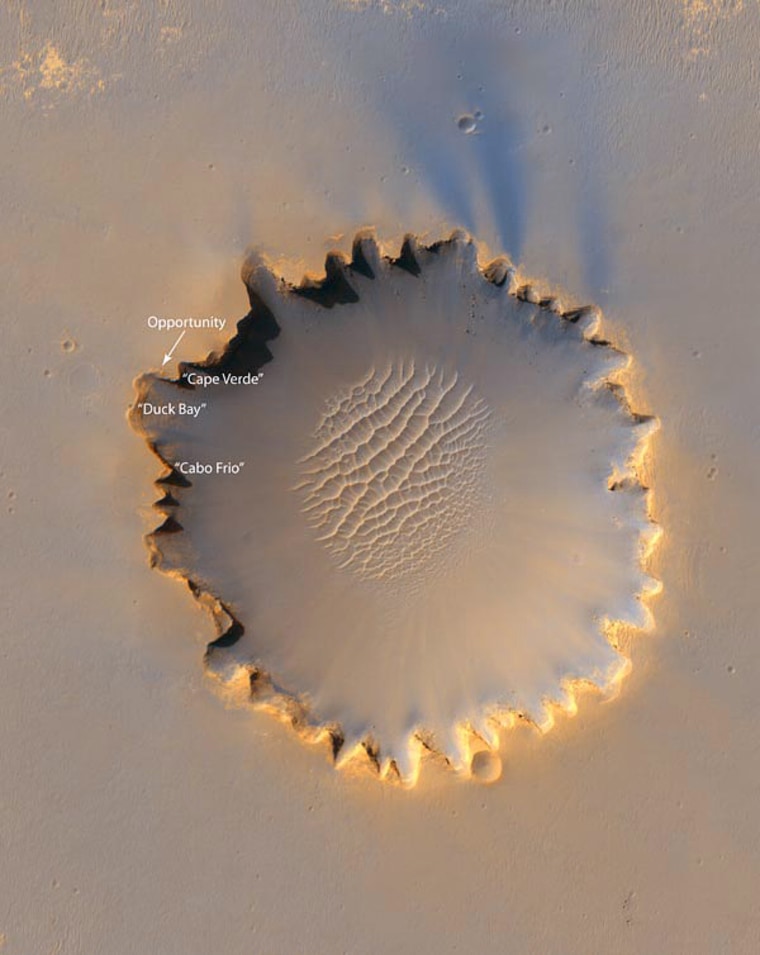NASA’s newest Mars orbiter has spied the plucky rover Opportunity perched at the rim of the Red Planet’s massive Victoria Crater as both vehicles explore the fourth planet from the Sun.
Appearing almost as a shiny boulder, Opportunity’s lumpy outline and its camera-mast shadow can easily be seen in a high-resolution image of Victoria Crater taken by NASA’s Mars Reconnaissance Orbiter (MRO)and released by the space agency on Friday.
“It is so good to see that rover again,” said Steve Squyres, the lead Mars Exploration Rover scientist from Cornell University in Ithaca, New York, during a press briefing. “I’ve got to say that image with that little rover 200 million miles away, parked at the top of that cliff, that’s just one of the most evocative images I’ve ever seen in the planetary program…it’s just beautiful.”
At half a mile wide (0.8 kilometers) and 200 feet (60 meters) deep, Victoria Crater is large enough to fit up to five football stadiums inside and is the biggest Martian crater to be visited by NASA’s red planet rovers, mission managers said.
“It’s probably the biggest crater we’re ever going to get to with Opportunity, or in fact with Spirit,” NASA’s Mars exploration program director Doug McQuistion said during the briefing. “The bottom line is it gives us a window on the past of the planet, and that’s incredibly important to understanding why it is the way it is and understanding relationships to potentially other rocky planets in the Solar System.”
Opportunity has spent 21 Earth months exploring the Meridiani Planum region of Mars, eventually working its way from its initial Eagle Crater landing site to Victoria. The rover’s robotic twin Spirit rolled across its own Gusev Crater landing site, scaled one of the region’s Columbia Hills and clambered down the other side. Together, the two rovers have produced some 160,000 images of the red planet.
“I think the whole Mars Exploration Rover program is an example of NASA at its best,” NASA chief Michael Griffin said during the briefing today at the agency’s Washington D.C. headquarters.
{
"type": "Slideshow",
"element": null,
"html": null,
"ecommerceEnabled": false
}“We haven’t even begun the prime mission yet, that starts in November,” said Alfred McEwen, MRO’s HiRISE principal investigator at the University of Arizona.
NASA launched the MRO orbiter in August 2005 and the probe arrived at the red planet last March. NASA released the first images from HiRISE, the largest telescopic camera ever sent to another world, on Sept. 29.
But MRO’s Victoria Crater images have already proved fruitful for Opportunity handlers, who are eager to probe deep within the depression to get at the ancient layered rocks revealed on outcrops and protrusions along the crater’s wall.
“We’re extremely excited to see changes in the layering that we see in the outcrops, because changes in layering mean changes in the environment,” Jim Bell, lead scientist for Opportunity’s panoramic camera, said during the briefing.
New look at old rocks
Early estimates pin Victoria Crater at somewhere between 10 million and 100 million years old, but the rocks within the depression themselves are likely much older – as in a few billion years in age, researchers said. Since the crater is also much deeper than any explored by Opportunity to date, the rover has an unprecedented chance to uncover secrets of the region’s distant past, they added.
“For me, this week has sort of felt like opening a book, like a mystery novel, where you read the first few pages and you’re hooked,” Bell said. “We’ve just opened the book on the story of Victoria Crater at Mars.”
Opportunity has already found evidence that subsurface water once soaked rocks at Meridiani Planum based on studies at Eagle Crater and the larger Endurance Crater, both of which are dwarfed by Victoria’s size.
Which way to go
Squyres said rover planners used MRO imagery as they planned Opportunity’s short trip from Duck Bay to a nearby bluff dubbed “Cape Verde" by mission team members. Victoria Crater itself borrows its name from the single surviving ship – of a fleet of five – of the historic Magellan expedition to circumnavigate the Earth in the 16th century.
MRO’s detailed portrait of Victoria Crater, combined with panoramic images taken by Opportunity, will be the foundation from which Squyres and his team shape the rover’s partial trek around the depression’s rim and, eventually, the descent into the crater itself.
A complete trip around the crater’s 1.5-mile (2.5-kilometer) rim would take up to nine months, and is likely unnecessary to obtain the needed data, mission managers said, though a small crater named Sputnik just 60 feet (18 meters) is an attractive target too.
“What we want to do is find a safe path in and a safe path out…we don’t want to make a suicide dive into the crater,” Squyres said. “We’re going to do this safely, we’re going to do it carefully, we’re going to do it when we’re ready.”
Rover handlers must now balance safety with aggressive driving to get the most science from what life Opportunity has left, Squyres added.
Opportunity is now into the 960th Martian day of a mission that was initially planned to span just 90 sols, the term for days on Mars. Now pushing more than 10 times its expected lifetime, Opportunity could fail at any moment, and Squyres attributed the rover's longevity to a robust design and adept handling by mission engineers and managers.
“You really have to respect this landscape because it is a potentially very, very dangerous place for the rover,” Bell said. “We have goo-goo eyes about the potential of what we can do, but we have to be very, very cautious.”
